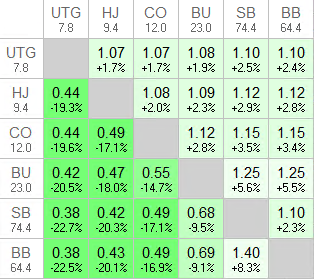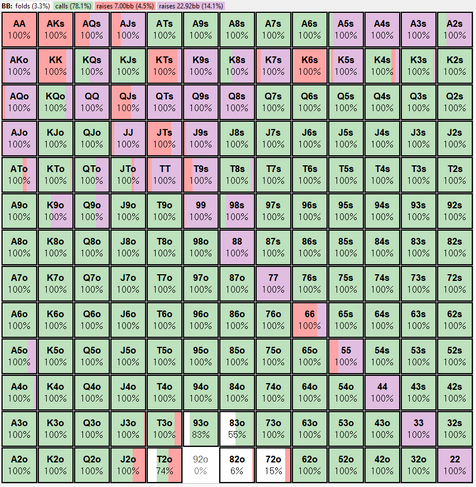OTB #026: How to Study Mystery Bounty Strategy
- support2956
- Dec 23, 2023
- 5 min read
Updated: 3 days ago

Bounty tournaments now make up over half of most schedules online.
PKOs, where you win 50% of your opponent's bounty straight away and the other 50% goes on your head, used to be the main bounty game available online.
Mystery bounties, on the other hand, where the bounty you win remains a mystery until you pull an envelope from a box, were reserved for live tournaments.
However, some of the online sites, specifically GG Poker and 888 Poker, led the way with mystery bounty tournaments online. Even PokerStars has now added some mystery bounty tournaments to their New Year series.
So today I want to show you how to study for the bounty portion of mystery bounty tournaments when the bounties are in play.
I'll show you how to set up Holdem Resources Calculator to run the spots and go through the kind of analysis you can do with this software so you can learn the major strategic differences between a vanilla tournament and a mystery bounty tournament.
Let's dive in...
How does a mystery bounty tournament work?
In the early stages, or initial phase, of a mystery bounty tournament, it's just like a regular tournament and there are no bounties available.
In the later stages, or the bounty phase, the mystery bounties kick in. Once you eliminate an opponent, you get to see how much was in their envelope and you immediately win that prize.
How much money goes into the regular prizepool and how much goes into the bounty prizepool can vary tournament to tournament.
In this example below, the total prizepool is $2,580 where $1,580 was reserved for the regular payouts (on the left hand side) and $1,000 was reserved for bounty payouts (on the right)
How do you set up HRC to run mystery bounty sims?
To work out the average bounty you need to know the total bounties available ($1,000) and the total number of players left in the tournament.
You can calculate it at any stage of the bounty phase of the tournament and you should make a habit of regularly knowing what it is so you know how to adjust your strategy.
At the start of the bounty phase in the tournament above there were 22 players left.
So the average bounty = $1,000 / 22 = $45.45
This number is crucial for running the sims in Holdem Resources Calculator
To make things interesting, and to remove the impact of the bubble, we're going to say there are 12 players left (so everyone is now in the money) and 10 bounties have already been won. Here's what's left:
$200 | 1 |
$100 | 2 |
$50 | 2 |
$30 | 3 |
$27 | 4 |
The total bounties remaining now equals $698 and there are 12 players left.
So the average bounty = $698 / 12 = $58.17.
If the big bounties are still available, the average bounty will of course be much higher. And this has a knock on effect on your strategies at all stack sizes.
You should enter the regular payouts as normal on the right hand side of Holdem Resources Calculator above.
Then go down to Bounty Mode and choose "KO" and input the average bounty size in KO Size($).
Don't make the mistake of selecting "PKO" here as that is reserved for progressive bounty tournaments and not mystery bounty tournaments.
We're going to explore this spot and I'll show you what you can learn and discover from just one sim:
HJ first in
Whenever you're studying and trying to solve these spots, you want to ask yourself questions while the sim runs. The last thing you want to do is just line check.
You'll notice I've even hidden Hero's hand because to improve your understanding of these spots, it's important to focus on ranges rather than on exact hands.
Here are some example questions from this one spot, designed to improve your understanding of the key differences between vanilla and mystery bounties:
How does my raise first in strategy change in a vanilla vs this spot in a mystery bounty?
How do the calling ranges of the CO round to the BTN change if I jam?
Does the BTN have a jamming range given their high risk premium against the blinds? If not, do they have a tight opening range instead?
How should I respond in the BB if the BTN minraises?
While the sim runs, you should try to answer these questions and then compare them to the actual solution.
Comparing risk premiums
Vanilla (left), Mystery Bounty (right)
Risk premium is the extra equity you need to realise either pre- or postflop in ICM situations.
In vanilla tournaments it will always be positive, but in any kind of bounty tournament you'll start to see negative risk premiums as well.
Notice that if you don't cover a player (e.g. CO vs SB) the risk premium is positive instead (3.5%), but interestingly, not as high as in the vanilla tournament (5.6%).
Hero (HJ) first in strategy
Every player behind you has you covered, which means they all have an incentive to get involved in hands against you. This is obviously going to have a huge impact on your strategy.
In the vanilla tournament (left) you can still minraise a polarised range and then jam a condensed range. In the mystery bounty tournament (right) you want to jam a linear range.
The effect of calling ranges when you jam from the HJ
Vanilla | Mystery bounty | |
CO | (9.2%) 66+, A9s+, ATo+ | (28.7%) 33+, A2s+, K5s+, Q7s+, J8s+, T7s+, 97s+, 87s, 76s, A7o+, K9o+, QTo+, JTo |
BTN | (8.4%) 77+, ATs+, ATo+ | (21.4%) 33+, A2s+, K9s+, Q9s+, JTs, A7o+, KTo+, QJo |
SB | (12.8%) 44+, A8s+, KJs+, A9o+, KQo | (54.1%) 22+, A2s+, K2s+, Q2s+, J2s+, T5s+, 95s+, 85s+, 74s+, 63s+, 52s+, 43s, A2o+, K5o+, Q8o+, J9o+, T8o+, 97o+, 87o, 76o |
BB | (19.2%) 22+, A2s+, KTs+, QTs+, A7o+, KJo+ | (100%) any two cards |
Because the players behind can call you so wide, you have to tighten up your jamming range. The small pairs (22-44) are now not profitable because you don't have as much fold equity and are flipping against more hands.
On the flip side, a hand like KTo is now a full frequency jam because you have better equity against the wider calling ranges.
BTN first in as a medium stack
In the vanilla (left) you get to open 32.1% of hands, but in the mystery bounty (right) you only get to open 23.2%. This is because the blinds are much more incentivised to play hands against you so you have less fold equity both pre and postflop.
BB vs a BTN open
Even though you're facing a tighter opening range from the BTN in a mystery bounty (right) you get to play a lot more hands than you do in the vanilla (left). And that is because you have a lot of incentive to play hands against the BTN because you can win their bounty.
Hands like J3o and 62o become calls and hands like A4s and K5s become jams.
Summary
Mystery bounties are a fun new addition to both online and live schedules.
Learning how to calculate the average bounty and then run sims will go a long way to helping you learn the differences in strategies.
Now it's just up to you to put in the work and explore the sims.
Good luck!


















